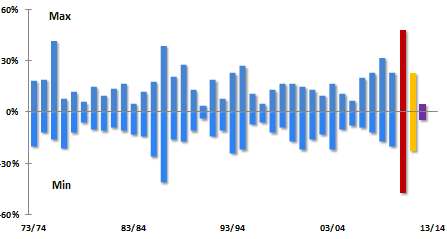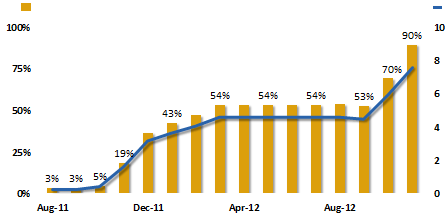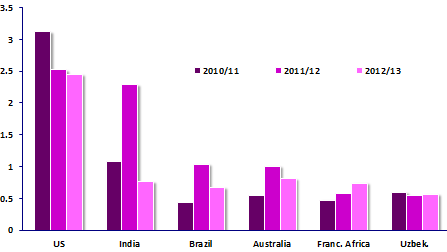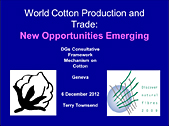NOTE:
THIS NEWS STORY is designed to help the public understand developments in the WTO. While every effort has been made to ensure the contents are accurate, it does not prejudice member governments’ positions.
MORE:
> Cotton sub-committee
> Agriculture negotiations: www.wto.org/agnegs
> Development: www.wto.org/development
KEY DOCUMENTS:
> “Evolving table” on aid: WT/CFMC/6... series
> Domestic cotton sector reform: WT/CFMC/21... series
> Documents and meetings lists: WT/CFMC/W/24... series
> All documents: WT/CFMC... series
Need help on downloading?
> Find help here
The $389 million that has been disbursed — $291m in completed projects and $97m in on-going activities — is an increase of $10m over the $379 million total reported in June. However, the amount spent so far on current projects is only 28% of the $354m committed, a proportion that has declined slightly.
Members agreed that efforts should be made to increase the proportion of committed money that is spent, although donors also explained that the apparently low proportion is partly because of timing: when the commitments were made, how long the projects last, what stage they are in, and when payments are made.
For the cotton assistance projects that have been completed, disbursements were 94% of the $309m committed.
The discussions took place in consultations held regularly since 2004 under a programme formally called the WTO “Director General’s Framework Mechanism on Cotton”. These meetings are separate from the negotiations on reforming cotton trade under the Doha Round agriculture negotiations, but both are mandated under the 1 August 2004 General Council decision in the Doha Round — paragraph 1(b) — and the 2005 Hong Kong Ministerial conference.
The consultations’ main purpose is to exchange information on aid for cotton, but members are also briefed on the latest developments in the negotiations and the latest market conditions, and they comment on those and on related developments.
In this meeting, members heard that a further $1.4bn has been spent on completed or continuing projects for agriculture and infrastructure, which also benefits cotton, in these cotton producing countries, with a total of $5bn committed, figures that are almost unchanged from six months ago.
Amounts committed and spent
Development assistance for cotton and agriculture, US$m
|
ACTIVE, ON-GOING |
COMPLETED |
||
|
Committed |
Spent |
Committed |
Spent |
Specifically for cotton |
354 |
97 |
309 |
291 |
For agriculture and infrastructure, also benefiting cotton |
4,707 |
1,101 |
306 |
304 |
Total |
5,061 |
1,198 |
615 |
595 |
The information is compiled in a document that is regularly updated, an “evolving table” now in its 14th version (document WT/CFMC/6/Rev.13 of 12 November 2012).
The meeting heard reports from donors, and from South-South development partners Brazil, India and China. Deputy Director-General Harsha Vardhana Singh, who chaired the meeting on behalf of Director-General Pascal Lamy, reiterated the importance of South-South cooperation.
He also said he would consult delegations on how to collect and circulate information on the quality of assistance from all sources. Although this is more complicated than simply reporting the amounts spent, some members said the recently-created focal points in recipient countries’ ministries could provide better feedback.
For the second time, in this meeting, some capital-based officials — the focal points — from the Cotton-4 proponents of cotton trade reform (Benin, Burkina Faso, Chad and Mali) were present. They thanked China for the financial support.
Trade negotiations
Meanwhile, the chairperson of the negotiations on cotton said he had little to report since the last meeting in June, although some delegates suggested they might submit some proposals in the coming months.
Ambassador John Adank of New Zealand, who chairs both the agriculture negotiations and the talks’ cotton sub-committee, noted that at the last meeting of the farm talks in November, one member said a proposal on cotton might be possible.
He repeated his observation that ministers agreed to include a section on cotton in the “Elements for political guidance” issued at the Geneva Ministerial Conference in December 2011 (paragraph 4 under “Trade and Development”), the only agricultural product to be highlighted in it.
African and other countries pushing for reform repeated their call for a quick, ambitious and specific solution on cotton as agreed in the 2005 Hong Kong Ministerial Declaration. These included the Cotton-4 proponents of cotton trade reform (Benin, Burkina Faso, Chad and Mali — Burkina Faso speaking).
Several complained that trade-distorting subsidies in some countries harmed producers in other countries. Some said they were concerned that new legislation in the US might increase the distorting subsidies, and the Cotton-4 said they would continue to discuss this with US officials in Washington and Geneva. The group also called for duty-free quota-free trade in cotton.
Unusual market situation
The situation in the world cotton market is unusual, with stable and high prices despite increasing production and large stocks, the International Cotton Advisory Committee (ICAC) told the meeting.
Repeating his observation in June about the declining price volatility, the ICAC delegate attributed this to a number of factors, including (but not only) the Chinese government’s policy of holding stocks in order to raise and stabilize domestic prices and to support its cotton growers. Reserves have risen from 3% of mill use in August 2011 to 90% in November 2012, he said.
The higher price, ICAC said, has led to a decline in Chinese mills’ use of cotton, and an increase in other countries, which have been able to fill the gap.
The ICAC delegate also compared production, mill use and exports in a number of African countries (see presentation on the right). He observed that with structural adjustment the cotton sector can sometimes increase production, but not always. For example, the sector expanded in Burkina Faso (where competition was introduced) and in Mali (where it wasn’t). In both cases only a small amount of cotton was used by local mills.
In Egypt, production has declined despite liberalization and a high proportion of cotton used by the mills, but this is partly because farmers are switching to more lucrative crops such as rice, he said.
Cotton production in Côte d'Ivoire and Zimbabwe has been resilient despite political problem, but use by mills has remained low, he said.
Tanzania has seen an increase in the use of cotton by processing mills as well as a rise in production, because of foreign direct investment from countries such as Thailand and Indonesia, and a location that is convenient for shipping exports to Asian markets, ICAC said.
Cotton price volatility
Highest and lowest prices in the cotton year, August to July, compared to the average price. 2010/11 was the most volatile, stabilizing in 2011/12 and particularly the first part of 2011/13

2012/13 = August-November. Source: ICAC
Estimated size of china national reserve, relative to mill use
Reserve as % of mill use National reserve, million tonnes

Source: ICAC
Cotton exports
Million tonnes

Source: ICAC
Background
Cotton has been a key issue in the agriculture negotiations and in development issues related to the WTO since 10 June 2003 when it was raised by Burkina Faso President Blaise Compaoré on behalf of the Cotton-4 (Benin, Burkina Faso, Chad and Mali) in a meeting of the Trade Negotiations Committee, which oversees the Doha Round negotiations.
The dual tracks of development (aid) and trade (negotiations) are mandated under the 1 August 2004 General Council decision in the Doha Round — paragraph 1(b) — and the 2005 Hong Kong Ministerial conference.
The first meeting on development assistance for cotton was in October 2004.
Meanwhile, successive chairs of the agriculture negotiations have said repeatedly that there will be no deal in agriculture if there is no deal in cotton.
The Cotton-4 (C-4) are supported by other African producers and the G-20 alliance of developing countries in the agriculture negotiations.
Chairperson: Deputy Director-General Harsha Vardhana Singh, on behalf of Director-General Pascal Lamy
Next meeting
Proposed: before the summer break in 2013
> Problems viewing this page?
Please contact [email protected] giving details of the operating system and web browser you are using.

